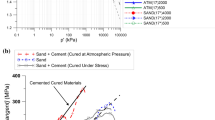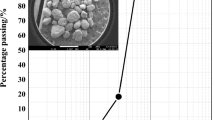Abstract
Biocement as an alternative to cement for soil improvement has been studied for the past decade. A comparative study on the cementation effect on the mechanical behavior of sand by biocement and Portland cement is presented. Drained triaxial tests were carried out on both cement- and biocement-treated sand. The yielding of cemented sand is largely associated with the breakage of bonding. Bonding ratio is defined in this paper to quantify the bonding effect. The bonding provided by biocement is stronger than that by cement, and as a result, the stress ratio at yielding for biocement-treated sand is higher than that for cement-treated sand given the other conditions the same. The shear resistance of cemented sand consists of bonding, dilation and friction. The stress–dilatancy relationship of biocement-treated sand is different from that of cement-treated sand or the Rowe’s stress–dilatancy equation. The increase in stress ratio with dilatancy ratio (1 − δεv/δε1) is higher for biocement-treated sand.
















Similar content being viewed by others
Abbreviations
- A*:
-
Parameter of the power function y = A*•(1 + x)B*
- B*:
-
Parameter of the power function y = A*•(1 + x)B*
- bc :
-
Biocement content
- bc ave :
-
Average biocement content for each group of bifocement-treated specimens
- cc :
-
Cement content
- cc ave :
-
Average cement content for each group of biocement-treated specimens
- D 50 :
-
Mean grain size (mm)
- d :
-
Dilatancy ratio (− δεpv/δεps)
- e s :
-
Intergranular void ratio
- e s,c :
-
Intergranular void ratio after consolidation
- M :
-
Effective stress ratio at critical state
- M μ :
-
Effective stress ratio corresponding to interparticle friction angle
- p′ :
-
Mean effective stress (kPa)
- q :
-
Deviatoric stress (kPa)
- v v :
-
Volume of voids
- v c :
-
Volume of cement (or biocement)
- v s :
-
Volume of sand particles
- ΔW :
-
Total work
- ΔW fric :
-
Energy dissipated by frictional loss
- ΔW bond :
-
Energy dissipated by bonding breakage
- δε a :
-
Incremental axial strain
- δε 1 :
-
Major principal total strain increment
- δε 3 :
-
Minor principal total strain increment
- δε v :
-
Incremental total volumetric strain
- δε s :
-
Incremental total shear strain
- δε p p :
-
Incremental plastic volumetric strain
- δε p s :
-
Incremental plastic shear strain
- φ f :
-
Friction angle during shearing
- φ cs :
-
Friction angle of critical state
- φ μ :
-
Interparticle friction angle
- δq :
-
Incremental deviatoric stress (kPa)
- σ 1 ′ :
-
Major principal effective stress (kPa)
- σ 3 ′ :
-
Minor principal effective stress/effective confining pressure (kPa)
- (σ 1 ′/σ 3 ′)p :
-
Stress ratio at peak point
- (σ 1 ′/σ 3 ′)r :
-
Residual stress ratio
- (σ 1 ′/σ 3 ′)y :
-
Stress ratio at yielding point
- η :
-
Stress ratio (q/p′)
- η bond :
-
Bonding ratio (ΔWbond/p′δεps)
References
Airey D (1993) Triaxial testing of naturally cemented carbonate soil. J Geotech Eng. https://doi.org/10.1061/(ASCE)0733-9410(1993)119:9(1379),1379-1398
Amini Y, Hamidi A (2014) Triaxial shear behavior of a cement-treated sand–gravel mixture. J Rock Mech Geotech Eng 6(5):455–465
ASTM D6913, D6913M-17 (2017) Standard test methods for particle-size distribution (gradation) of soils using sieve analysis. ASTM, West Conshohocken
Burbank MB, Weaver TJ, Williams BC, Crawford RL (2012) Urease activity of ureolytic bacteria isolated from six soils in which calcite was precipitated by indigenous bacteria. Geomicrobiol J 29(4):389–395
Cheng L, Cord-Ruwisch R, Shahin MA (2013) Cementation of sand soil by microbially induced calcite precipitation at various degrees of saturation. Can Geotech J 50(1):81–90
Cheng L, Shahin MA, Chu J (2019) Soil bio-cementation using a new one-phase low-pH injection method. Acta Geotech 14(3):615–626
Chou C, Seagren E, Aydilek A, Lai M (2011) Biocalcification of sand through ureolysis. J Geotech Geoenviron Eng. https://doi.org/10.1061/(ASCE)GT.1943-5606.0000532,1179-1189
Chu J, Ivanov V, Stabnikov V, Li B (2013) Microbial method for construction of an aquaculture pond in sand. Géotechnique 63(10):871–875
Chu J, Leong WK (2002) Effect of fines on instability behaviour of loose sand. Géotechnique 52(10):751–755
Clough GW, Sitar N, Bachus RC, Rad NS (1981) Cemented sands under static loading. J Geotech Geoenviron Eng 107 (ASCE 16319 Proceeding)
Consoli NC, da Fonseca AV, Silva SR, Cruz RC, Fonini A (2012) Parameters controlling stiffness and strength of artificially cemented soils. Géotechnique 62(2):177–183
Cuccovillo T, Coop MR (1999) On the mechanics of structured sands. Géotechnique 49(6):741–760
Cui MJ, Zheng JJ, Zhang RJ, Lai HJ, Zhang J (2017) Influence of cementation level on the strength behaviour of bio-cemented sand. Acta Geotech 12(5):971–986
DeJong JT, Fritzges MB, Nüsslein K (2006) Microbially induced cementation to control sand response to undrained shear. J Geotech Geoenviron Eng. https://doi.org/10.1061/(ASCE)1090-0241(2006)132:11(1381),1381-1392
DeJong JT, Soga K, Kavazanjian E et al (2013) Biogeochemical processes and geotechnical applications: progress, opportunities and challenges. Géotechnique 63(4):287–301
Feng K, Montoya B (2015) Influence of confinement and cementation level on the behavior of microbial-induced calcite precipitated sands under monotonic drained loading. J Geotech Geoenviron Eng. https://doi.org/10.1061/(ASCE)GT.1943-5606.0001379,04015057
Gai X, Sánchez M (2019) An elastoplastic mechanical constitutive model for microbially mediated cemented soils. Acta Geotech 14(3):709–726
Haeri SM, Hosseini SM, Toll DG, Yasrebi SS (2005) The behaviour of an artificially cemented sandy gravel. Geotech Geol Eng 23(5):537–560
Ismail MA, Joer HA, Sim WH, Randolph MF (2002) Effect of cement type on shear behavior of cemented calcareous soil. J Geotech Geoenviron Eng. https://doi.org/10.1061/(ASCE)1090-0241(2002)128:6(520),520-529
Ivanov V, Chu J (2008) Applications of microorganisms to geotechnical engineering for bioclogging and biocementation of soil in situ. Rev Environ Sci Bio/Technol 7(2):139–153
Kenney TC (1997) Residual strength of mineral mixtures. Proc 9th Int Conf Soil Mech Found Eng 1:155–160
Kuerbis, R, Negussey, D, Vaid, YP (1988) Effect of gradation and fines content on the undrained response of sand. Geotechnical Special Publication No. 21, ASCE, pp 330–345
Li D, Liu X, Liu X (2015) Experimental study on artificial cemented sand prepared with ordinary portland cement with different contents. Materials 8(7):3960–3974
Lin H, Suleiman MT, Brown DG, Kavazanjian E Jr (2016) Mechanical behavior of sands treated by microbially induced carbonate precipitation. J Geotech Geoenviron Eng. https://doi.org/10.1061/(ASCE)GT.1943-5606.0001383,04015066
Lo SC, Lade PV, Wardani S (2003) An experimental study of the mechanics of two weakly cemented soils. Geotech Test J 26(3):328–341
Mahawish A, Bouazza A, Gates WP (2018) Effect of particle size distribution on the bio-cementation of coarse aggregates. Acta Geotech 13(4):1019–1025
Malandraki V, Toll DG (1996) The definition of yield for bonded materials. Geotech Geol Eng 14(1):67–82
Martinez B, DeJong J, Ginn T, Montoya B, Barkouki T, Hunt C, Tanyu B, Major D (2013) Experimental optimization of microbial-induced carbonate precipitation for soil improvement. J Geotech Geoenviron Eng. https://doi.org/10.1061/(ASCE)GT.1943-5606.0000787,587-598
Mitchell JK (1993) Fundamentals of soil behavior, 2nd edn. Wiley, New York
Montoya BM, DeJong JT, Boulanger RW (2013) Dynamic response of liquefiable sand improved by microbial-induced calcite precipitation. Géotechnique 63(4):302–312
Montoya B, DeJong J (2015) Stress-strain behavior of sands cemented by microbially induced calcite precipitation. J Geotech Geoenviron Eng. https://doi.org/10.1061/(ASCE)GT.1943-5606.0001302,04015019
Mujah D, Cheng L, Shahin MA (2019) Microstructural and geomechanical study on biocemented sand for optimization of MICP process. J Mater Civ Eng. https://doi.org/10.1061/(ASCE)MT.1943-5533.0002660,04019025
Mujah D, Shahin MA, Cheng L (2016) State-of-the-art review of bio-cementation by microbially induced calcite precipitation (MICP) for soil stabilization. Geomicrobiol J 34(6):524–537
O’Donnell T, Kavazanjian E Jr (2015) Stiffness and dilatancy improvements in uncemented sands treated through MICP. J Geotech Geoenviron Eng. https://doi.org/10.1061/(ASCE)GT.1943-5606.0001407,02815004
Porcino DD, Marcianò V (2017) Bonding degradation and stress–dilatancy response of weakly cemented sands. Geomech Geoeng 12(4):221–233
Qabany AAL, Soga K (2013) Effect of chemical treatment used in MICP on engineering properties of cemented soils. Géotechnique 63(4):331–339
Qabany AAL, Soga K, Santamarina C (2012) Factors affecting efficiency of microbially induced calcite precipitation. J Geotech Geoenviron Eng. https://doi.org/10.1061/(ASCE)GT.1943-5606.0000666,992-1001
Quiroga AJ, Thompson ZM, Muraleetharan KK, Miller GA, Cerato AB (2017) Stress–strain behavior of cement-improved clays: testing and modeling. Acta Geotech 12(5):1003–1020
Rios S, Da Fonseca AV, Baudet BA (2014) On the shearing behaviour of an artificially cemented soil. Acta Geotech 9(2):215–226
Roscoe KH, Schofield AN, Thurairajah A (1963) Yielding of clays in states wetter than critical. Géotechnique 13(3):211–240
Rowe PW (1962) The stress-dilatancy relation for static equilibrium of an assembly of particles in contact. Proc R Soc Lond Math Phys Eng Sci 269(1339):500–527
Schnaid F, Prietto PD, Consoli NC (2001) Characterization of cemented sand in triaxial compression. J Geotech Geoenviron Eng. https://doi.org/10.1061/(ASCE)1090-0241(2001)127:10(857),857-868
van Paassen LA, Ghose R, van der Linden TJM, van der Star WRL, van Loosdrecht MCM (2010) Quantifying biomediated ground improvement by ureolysis: Large-scale biogrout experiment. J Geotech Geoenviron Eng. https://doi.org/10.1061/(ASCE)GT.1943-5606.0000382,1721-1728
Wang Y, Leung S (2008) Characterization of cemented sand by experimental and numerical investigations. J Geotech Geoenviron Eng. https://doi.org/10.1061/(ASCE)1090-0241(2008)134:7(992):992-1004
Wang Y, Leung S (2008) A particulate-scale investigation of cemented sand behavior. Can Geotech J 45(1):29–44
Whiffin VS, van Paassen LA, Harkes MP (2007) Microbial carbonate precipitation as a soil improvement technique. Geomicrobiol J 24(5):417–423
Acknowledgements
We would like to acknowledge gratefully that the work presented in this paper is partially supported by the Ministry of Education (MOE2015-T2-2-142) and by Nanyang Technological University (NTU) for providing the scholarship to the first author and the support to Centre for Urban Solutions at NTU.
Author information
Authors and Affiliations
Corresponding author
Additional information
Publisher's Note
Springer Nature remains neutral with regard to jurisdictional claims in published maps and institutional affiliations.
Rights and permissions
About this article
Cite this article
Wang, L., Chu, J., Wu, S. et al. Stress–dilatancy behavior of cemented sand: comparison between bonding provided by cement and biocement. Acta Geotech. 16, 1441–1456 (2021). https://doi.org/10.1007/s11440-021-01146-4
Received:
Accepted:
Published:
Issue Date:
DOI: https://doi.org/10.1007/s11440-021-01146-4




